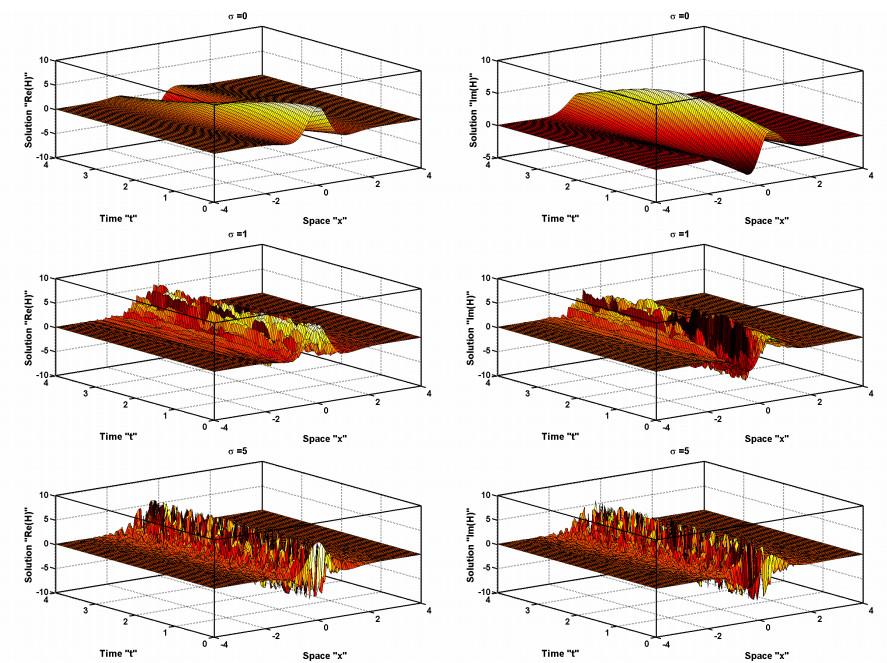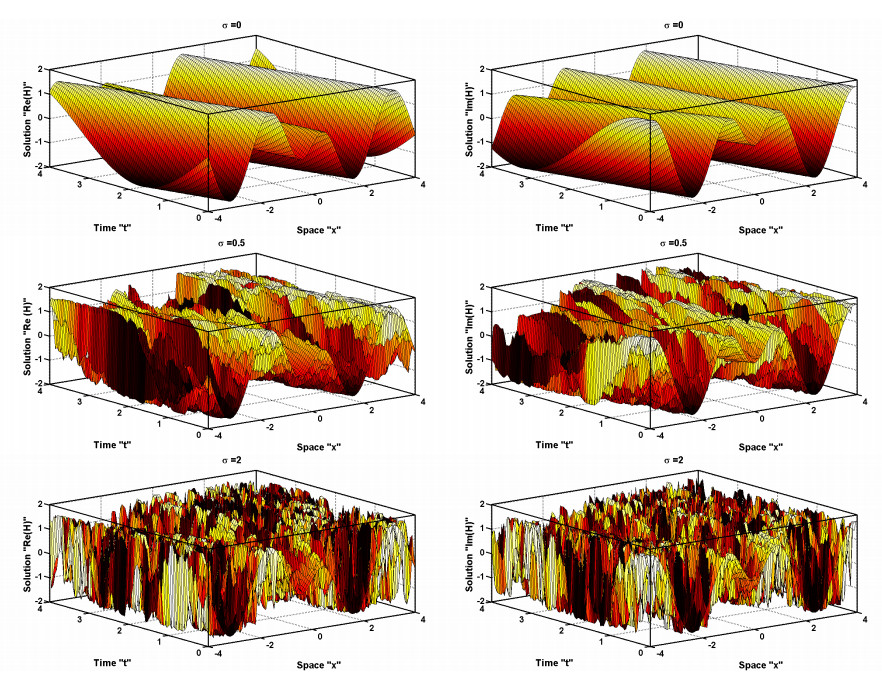1.
Introduction
Nonlinear partial differential equations (NLPDEs) can be used to mimic many nonlinear phenomena that arise in a various scientific fields, including geology, fluid dynamics, biology, chemical physics, Optics, plasma physics and solid state physics [1,2,3,4,5,6,7,8,9]. Many researchers have recently become interested in studying the dynamics of these models [10,11,12,13]. One of the basic models of nonlinear waves is the nonlinear Schrodinger equation (NLSE) [14,15]. It is used in a variety of fields, including electromechanical systems [16], laser beams [17], and the theory of crystals [18] and solids [19].
General random disturbances Spontaneous emissions and Thermal fluctuations can be modeled using stochastic Schrodinger models. Many authors investigated the uniqueness and existence of stochastic NLSEs with multiplicative or additive noise. The case of additive noise is investigated in [20,21] while the case of multiplicative noise if reported in [22,23]. Both types of noises are investigated in [24,25]. In addition, Numerical methods are used to study the stochastic NLSE in [26,27].
In this context, the stochastic Fourth order NLSE with quantic nonlinearity and affected by multiplicative noise. This stochastic model has not been studied before. This model reads as:
where Ht represents the linear temporal evolution. Hx represents the inter-modal dispersion. Hxxx and Hxxxx represent the third order and fourth order dispersion. Hxx represents the group velocity dispersion. β1 and β2 represent the coefficients of self phase modulation effect and quantic nonlinearity. Bt is the stochastic term which represents the white noise. B(t) and follow the next conditions:
(i) For t≥0, B(t) has continuous trajectories.
(ii) For s<t, B(t)−B(s) has independent increments.
(iii) B(t)−B(s) has a normal distribution with variance =t−s and mean=0.
This model is used to describe the wave propagation through optical fibers. This model includes the dispersion and nonlinearity effects. Dispersion is also known as wave broadening or wave spreading. Some of the optical power in a propagated wave is delayed at the fiber's output end, which results in dispersion [28]. Dispersion shows how optical power that enters the fiber simultaneously leaves at various moments. Because of dispersion, the optical wave width grows continually across the fiber. The output signal varies from the input signal when dispersion reaches the data rate's maximum value [29]. In addition, The intensity dependence of the medium's refractive index causes nonlinear effects in optical fiber. Optical soliton is a special type of solutions that can propagate to very large distance retaining its shape and speed. This optical wave is generated due to dedicated balance which occurs between the dispersion and nonlinear effects [30,31]. In addition, adding the noise effect to the investigated model is very necessary to show the robust of the extracted solutions against the noise. Research into all these different influences is making a huge contribution to the development of the telecommunications industry [29].
The nonlinear stochastic Chiral Schrödinger equation (CNLSE) in two dimensions was investigated in literature [32] to extract periodic envelopes, explosive, dissipative, symmetric solitons, and blow up waves. It was confirmed that the noise factor is dominant on all the wave conversion, growing and damping of envelopes and shocks. In ref [33], the stochastic NLSE with group velocity dispersion and self modulation nonlinear effect was studied by applying the unified solver approach to extract rational, dissipative, explosive, envelope, periodic, and localized soliton solutions.
In this current work, the improved modified extended tanh function scheme is utilized to provide optical solitons for the stochastic NLSE in (1.1). In addition, this method provide other solutions such as trigonometric, hyperbolic and exponential type solutions. The proposed method is briefly introduced in Section 2. Then, the stochastic solutions are extracted for the investigated model in Section 3. The effect of the multiplicative noise on the obtained solutions is discussed in Section 4. Finally, the work is concluded.
2.
Revisitation of the technique
This section introduces the improved modified extended tanh scheme [34].
Considering the following NLPDE:
where G is polynomial in H(x,t) and its partial derivatives
Step 1: The following mathematical transformation is applied
Therefore, Eq (2.1) is converted to the following ODE:
Step 2: The solutions for Eq (2.3) is supposed in the form:
where A(ξ) holds:
By changing the values of the constants d0,d1,d2,d3 and d4, one can obtain different general solutions for Eq (2.5).
Step 3: N that raised in Eq (2.4) can be evaluated by applying the balancing rule on Eq (2.3).
Step 4: Substituting by Eq (2.4) with (2.5) into (2.3), a polynomial in A(ξ) is provided. Collecting the terms which have the same power together and equating them to zero, one get a system of nonlinear equations that can be solved using packages of Mathematica to determine λ,ak and bk.
3.
Results
In this section, the improved modified extended tanh method is applied to provide stochastic solutions for the proposed model in the following form:
Substituting by (3.1) into (1.1) provides
and
where Eq (3.2) represents the imaginary part while Eq (3.3) is the real part.
Equating the coefficients of (3.2) to zero gives
Balancing F(4) with F5, we get N=1. Then, the solution of Eq (3.3) can be represented as follow:
By employing Step 4 which discussed in the last section, we can obtain the next results for (1.1) :
Case 1. d0=d1=d3=0
Result (1)
Then, we obtain the following stochastic bright soliton and singular periodic solutions for (1.1).
Case 2. d1=d3=0
Result (1)
Then, we obtain the following stochastic dark soliton and singular periodic solutions for (1.1).
Result (2)
Then, we obtain the following stochastic singular soliton and singular periodic solutions for (1.1).
Result (3)
Then, we obtain the following stochastic singular soliton and singular periodic solutions for (1.1).
Case 3. d0=d1=0
Result (1)
Then, we obtain the following stochastic dark soliton for (1.1).
Case 4. d3=d4=0
Result (1)
Then, we obtain the following stochastic singular soliton and singular periodic solutions for Eq (1.1).
Result (2)
Then, we obtain the next stochastic exponential solution for (1.1).
Case 5. d2=d4=0
Result (1)
Then, we obtain the next stochastic Weierstrass elliptic solution for (1.1).
where g2=−4d1/d3 and g3=−4d0/d3.
4.
Influence of the noise on the extracted solutions
In this section, we investigate the effect of the multiplicative noise on the derived solutions. 2D and 3D simulations using different values for σ are presented using Matlab packages. In Figure 1, 3D graphical illustrations of Eq (3.6) are introduced with α4=−0.13,α2=2,β2=0.055,β1=−2,k=−2,λ=−0.095,w=1. In Figure 2, 2D graphical illustrations of Eq (3.6) is presented using different noise intensities. In Figure 3, 3D graphical illustrations of Eq (3.8) are provided with α4=0.49,α2=−2,β2=−2,β1=−2,k=−2,λ=−0.63,w=1. In Figure 4, 2D graphical illustrations of Eq (3.8) is presented using different noise intensities. It is observed that as the noise intensity increases, the extracted wave begins to degrade. From Figures 1–4, we also observed that the higher level wave is more robust to noise than the lower level wave. One can notice that the propagated wave of Eq (3.6) is fully distorted when σ=5 as shown in Figures 1 and 2 while the propagated wave of Eq (3.8) is fully distorted when σ=2 as shown in Figures 3 and 4. The signal level of the obtained solutions can be controlled to be robust against the noise by adjusting coefficients of the fourth order dispersion, group velocity dispersion, self phase modulation and the quantic nonlinearity.
5.
Conclusions
In this work, The improved modified extended tanh function method is implemented successfully to investigate stochastic forth order NLSE with quantic nonlinearity and affected by multiplicative noise. Many exact optical solutions are extracted in terms of hyperbolic, trigonometric, exponential and Weierstrass elliptic solutions. This stochastic model with fourth-order dispersion and quantic nonlinearity has not been studied before. Therefore, all of these extracted solutions are new. These solutions are crucial in understanding some complex physical phenomena. The extracted solutions will be useful in future studies like coastal water motions, industrial studies, quasi particle theory, optical fiber and space plasma applications. Matlab packages are used to simulate the effect of the multiplicative noise on the derived solutions.
Acknowledgments
The researchers would like to thank the Deanship of Scientific Research, Qassim University, for funding the publication of this project.
Conflict of interest
The authors declare no conflict of interest.










 DownLoad:
DownLoad:






